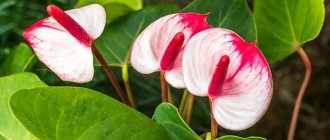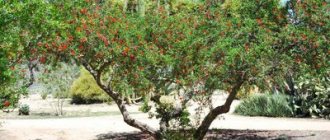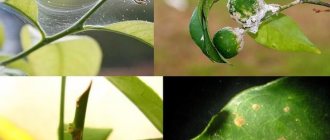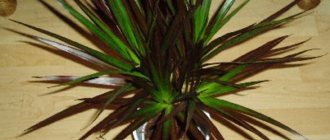People learned to grow fruit trees in their homes a long time ago. They develop well indoors, grow quickly, can be molded, bloom and delight their owners with delicious fruits. One of the most popular are citrus indoor plants.
Citrus trees grow in India, Australia, China, Japan, in tropical or subtropical climates. These regions always have warm and humid air and plenty of sunshine throughout the year. Tasty and aromatic fruits grow on trees and shrubs. Trees in natural conditions grow up to 12 m high.
The peculiarities of growing citrus plants include their uneven growth: the vigorous development of young shoots alternates with a period of dormancy.
Homemade citrus
Citrus fruits are mainly remontant plants and can produce crops several times a year.
To obtain fruits, it is best to purchase grafted seedlings or rooted cuttings of Citrus fruits.
Their flowers are bisexual.
Although most Citrus fruits are self-pollinating, flower growers recommend artificial pollination. This will increase the fruit yield.
The fruit ripening period lasts from 5 to 9 months.
Plant propagation is carried out using seeds, as well as cuttings and grafting.
Citrus diseases
Indoor trees: caring for an Arabica coffee plant at home
Diseases can be associated with physiological disorders caused by a deficiency or, conversely, an excess of microelements.
Some signs of excess or deficiency of microelements:
- Mature leaves are dull and turn yellow. This is due to a lack of nitrogen. If there is rapid growth of young shoots, the plant fattens and does not bloom, then there may be an excess of nitrogen in the soil.
- The leaves turn yellow and become smaller, flowering is weak. There may be a lack of phosphorus in the soil. If there is an excess of a microelement, the plant develops and grows poorly;
- The leaf plate warps, pits form on it, folds appear on the leaf along the veins, some of the branches die off, and foliage falls off during the flowering period. This is possible due to a lack of potassium. If there is an excess of potassium, brown necrotic burns appear along the edges of the leaf;
Lemon leaf for potassium deficiency
- The growth of defective young leaves and the death of growth points are provoked by a lack of calcium and boron;
- With a lack of iron, manganese, zinc or sulfur, leaf chlorosis is observed (green veins are clearly visible on yellow leaves), young shoots die.
Citrus plant disease can be caused by pests. These include:
- scale insect and false scale insect (appearance of wax plaques on leaves and branches);
- mealybug (appearance of white lumps in the axils of the leaves);
- aphids (a cluster of small black insects on young shoots);
- spider mite (yellow dots form on the leaves, a white coating appears below).
Fungal diseases include:
- malseco (the branches turn black and then begin to dry);
- gum bleeding (the appearance of liquid from a wound on the branches and trunk);
Gum treatment
- anthractic disease (the appearance of wet spots on a leaf, which eventually merge into one);
- powdery mildew (white coating on leaves).
When a disease is detected, it is necessary to adjust the watering and feeding of the plant. In case of fungal diseases, damaged branches are removed and sprayed with fungicides.
Caring for indoor citrus fruits
In order for indoor citrus to develop and bear fruit normally, it is necessary to organize proper watering, lighting, and also set the optimal temperature and humidity.
Watering mode
Aechmea - home care, indoor species
Plants should be watered moderately and regularly. They do not like drought, but waterlogging is also unacceptable for them. The signal for watering is the top dried layer of soil. In summer, watering is done daily, in winter - as needed, the main thing is that the soil does not dry out.
Attention! After proper watering, some of the water should flow into the pan.
Temperature and humidity
For normal development and fruiting of plants, the ambient temperature should be between +18 and +22°C. Higher and lower lead to inhibition of the development of indoor plants.
In spring and summer, the flower pot can be taken out onto the loggia or balcony.
It is also necessary to maintain humidity around 70%. To do this, in the summer, wipe the leaves with a damp cloth, install a humidifier near the flower pot, or spray the plant with soft water.
Top dressing
Fertilizers are applied only during the growing season. Fertilizing is carried out in pre-moistened soil.
To maintain beneficial microflora, use the drug Baikal or Vostok EM-1.
You can feed it with organic fertilizers. To do this, take an infusion of horse manure at the rate of 100 g per 1 liter of water. Infuse the fertilizer for 2 weeks.
You can use an infusion of chicken manure or cow manure in a proportion of 40 g per 1 liter of water.
Note! To apply mineral fertilizing, special complex fertilizers for citrus fruits are used.
Mineral and organic fertilizers are applied alternately every 10 days.
Nitrogen compounds are not used during flowering. During this period, the plant needs phosphorus and calcium.
Wintering plants
In winter, the air temperature should be lowered. If the room is warm, the life processes of the tree will proceed quite actively. Since citrus photosynthesis is slow during this period, the plant does not receive additional energy. As a result, the tree will become depleted, which may lead to its death.
This time is called the rest period. It lasts from November to February. Then the citrus wood ripens and young shoots do not grow.
The air temperature during this period is maintained depending on the type of Citrus fruit. To maintain a 12-hour daylight hours for citrus fruits, artificial lighting is provided.
Proper water: what is it?
The most suitable water for watering citrus trees is rain or melt water. This water has a low content, which is why it is also called “soft”. Rainwater is generally considered the softest; it can be collected, brought to room temperature and watered by plants. You can also mix clean rainwater with settled tap water, this helps eliminate its excessive softness.
Other types of water: tap water, water from wells and streams are not suitable for irrigation due to the high salt content. This leads to a significant increase in soil alkalinity.
Homemade orange seed
Ripsalidopsis: home care and plant varieties
An orange tree can be grown at home from an orange seed purchased in a store. However, in this case it will not bloom earlier than in 7-10 years. In a pot it can reach 3 meters in height.
Orange tree
If you want to get a harvest faster, it is better to graft or propagate the orange using cuttings. After grafting or after planting a cutting, the plant can bloom in 3-4 years.
Conditions for germinating orange seeds
In order to grow a seedling, you must follow the following step-by-step procedure:
- Preparation of seed material;
- Preparation of soil and containers for growing seedlings;
- Replanting seeds;
- Sowing care;
- Picking and transplanting a finished seedling.
It is better to plant an orange in early spring so that there is sufficient natural light for the seedlings.
How to choose a fruit of the desired maturity and separate the stone
To obtain seeds, you need to take fully ripened fruits, without damage or rot. Ripe oranges have a rich, specific smell and are heavy in weight. The fruit should be evenly colored and free of spots.
The most round, large and full-bodied seeds are selected. They are immediately freed from pulp, washed in water and soaked for 12-24 hours in water or a solution of Epin or another growth stimulant. Soaking will soften the outer shell of the seeds, which will allow the seeds to germinate faster.
Attention! Dried seeds are not used for germination, as the thick skin will prevent germination.
Preparing the soil mixture and choosing a pot
Soil for planting can be purchased at the store, or you can make it yourself. To prepare the soil mixture, use leaf soil, sand and peat, taken in equal quantities, or leaf soil and peat.
For sowing, you can use small containers with drainage holes.
Stages of seed preparation
A drainage layer of expanded clay, vermiculite, etc. is placed at the bottom of the pot. Soil is poured on top and compacted a little.
Planting and growing seedlings
The seed should be planted shallowly, to a depth of 1-1.5 cm.
The prepared pots are placed in a warm place. Lighting does not play a role at this stage. To create a greenhouse effect, they are covered on top with a piece of polyethylene or a cut plastic bottle.
You can pre-germinate the seeds. To do this, place a cloth in the container, which is pre-moistened. Seeds are placed on it, which is also covered with a damp cloth. They are setting up a greenhouse. After a few weeks, the seeds will germinate. After germination, the seedlings are transferred to a well-lit place.
When 2 leaves appear, the seedlings need to be picked; when 4 leaves appear, they are transplanted by transshipment to a permanent place.
Orange tree seedlings
Pots with seedlings are placed on south-eastern or south-western window sills.
Seed and sprout watering mode
When germinating a seed, the soil should not be too dry or waterlogged. Therefore, the ground is periodically sprayed with water from a spray bottle. After germination, the soil should also be moderately moist.
Ways to Improve Your Water
What to do if it is not possible to water your lemon with rain or melt water?
There are ways to improve regular tap water to make it softer without harming your plant.
The first, and easiest way, is to defend. You just need to pour tap water into an open container and leave it for about two days. After this time, a little lime will leave the water and chlorine will evaporate.
The second method is boiling. Tap water needs to be heated to a boil, cooled and the plant watered with this water. After this procedure, chlorine will be removed from the water, and lime will settle along the walls of the container. But this method also has a disadvantage - the amount of oxygen will become less.
Tap water can be made suitable for watering citrus fruits by adding a small amount of wood ash (about half a teaspoon for every liter of water) or fresh peat (about 50 grams per 5 liters of water, it needs to be wrapped in a cloth and dipped in water for about for a day).
The next method is filtering. Simply run your tap water through a filter; it will trap harmful impurities.
Various chemicals can also help improve your water. You can add various acids to water: citric (0.5 g per 3 liters of water), acetic (4-5 drops per liter of water) or oxalic (2 g per 10 liters of water).
Succinic acid not only “softens” water, but also has a beneficial effect on the condition of plants
Another acid that can improve your tap water is succinic acid. It can significantly improve the processes of their growth and development. This acid has a number of useful properties:
- — stimulates plant growth;
- — improves the absorption of nutrients from the soil;
- — activates root growth;
- — increases the plant’s stress resistance;
- — absolutely harmless to plants, the environment and humans, does not require any special disposal measures.
Succinic acid also has a positive effect on the soil in which citrus is grown. It improves soil microflora, destroys toxic substances and man-made pollution in it.
Citrofortunella home care (calamondin)
Kalamandin what is it
Another evergreen citrus plant with a beautiful name is calamondin citrus. It appeared as a result of crossing kinkan and mandarin plants. It is also called Chinese mandarin and golden orange. They are grown indoors and in winter gardens. Can be presented in standard form or as a bonsai.
Bonsai calamondin
Under natural conditions it grows in height from 3 to 7 m, at home – from 0.6 to 1.5 m.
The flowers are white, self-pollinating.
The calamondin fruit is orange in color, round, slightly flattened at the top and bottom, up to 4.5 cm in size. The pulp is sour, consists of 6-8 lobules, covered with a thin, aromatic skin.
Care
Citrofortunella grows well indoors. Calamondin care involves creating optimal conditions for the development and fruiting of the plant.
Illumination
One of the requirements for caring for calamondin at home is the organization of lighting. Daylight should not be less than 12 hours, so in winter there is a need for artificial lighting. In summer, it is advisable to place a citrus hybrid in the garden. The place should be slightly shaded so that direct sunlight does not hit the plant.
Temperature
During the growing season, the ambient temperature should be between +18 and 27°C. If the temperature is high, the plant will drop its fruits.
Calamondin fruit
During the rest period, the temperature is reduced to +10-15°C.
How to water
The soil in the pot should be moderately moist. Water the plant daily in summer, in winter - no more than once every 1-2 weeks.
For irrigation, the water should be soft and at room temperature. After watering, the water that has spilled into the pan is removed. If the air is dry, then additionally spray the crown.
Top dressing
Fertilizer is applied during the growing season once every 7-10 days. For this purpose, complex fertilizers for citrus fruits are used.
Attention! During the dormant period, fertilizing is not carried out.
Earth mixture
Neutral soil is used. You can use special soil for citrus fruits. To prepare the soil yourself, take 2 parts of turf soil and 1 part each of rotted manure and sand.
Fruiting
The apples and pears we are all familiar with ripen within a few months. With citrus fruits the situation is different: it can take seasons for the fruit to reach full ripeness from the beginning of flowering! Tangerines will produce the fastest harvest (about six months), oranges will produce the slowest (at least eight months). Lemons fall somewhere in the middle.
If the ranetki quickly fall off and begin to rot, then homemade citrus fruits can not be picked until the next fruiting (although there is a high risk that the pulp will not taste as juicy and bright). This only applies to tangerines and oranges; lemons can hang for two years without losing their taste. At the same time, they change in a funny way: the golden fruit grows larger and turns green, and after a while it becomes yellow again.
Lemon fruits are green at first and gradually turn yellow as they ripen.
Hesperidium is the name of the fruit of indoor tangerine or lemon. The structure is specific - a berry made of juice-filled slices, each of which is enclosed in its own shell, poorly permeable to water and any other substances. For this reason, the content of vitamins and minerals in different parts of the fruit is not the same.
The juice and peel of citrus fruits (most of all in oranges, less in lemons) contain carotenoids - precursors of vitamin A. They are organic pigments that give the fruit a bright yellow or orange color. These fruits strengthen the immune system, improve the functioning of the circulatory system, and have a beneficial effect on the digestive tract. And in rooms where there are tubs with citrus trees, the air is much cleaner than in an ordinary room - thanks to the active release of phytoncides.
Growing homemade lemons requires a lot of effort. It is necessary to carefully maintain sufficient humidity and temperature for citrus; pinch the plant in time, replant it in fertile soil, add fertilizer to the soil and remove excess ovaries and buds, and water it properly.
How to care for a lemon tree at home
Caring for lemon, just like any other citrus fruit, consists of properly organizing the conditions for its development. The most suitable varieties for growing indoors are Pavlovsky, Eureka and Maikop.
Lemon Tree
Illumination
Daylight hours for a lemon tree should be at least 12 hours. The most suitable places are south-east and south-west windows.
Do not allow direct sunlight to hit the leaves of the plant. If the flower pot is located on the south window, then in the summer you need to shade the citrus. In winter, additional lighting is provided in the evening hours.
Temperature
During flowering, it is necessary to maintain the ambient temperature no higher than 20°C, otherwise high temperatures will cause flowers to fall off.
In winter, the optimal temperature for lemon will be from +14 to +16°C.
How to water
Depending on the temperature and dryness of the air, watering is carried out daily or once every 2 days in the summer, and 2 times a month in winter.
Important! To prevent rotting of the roots, the water remaining in the pan after watering is drained.
It is advisable to wipe the leaves from dust and dirt at least once a month. This will help improve the photosynthesis of the plant.
Top dressing
For normal plant development, it is recommended to fertilize with mineral compounds once every 2 weeks during the growing season (from March to September). Fertilizer is applied after watering. You can use an infusion of cow dung and an infusion of wood ash. It is better to alternate fertilizers.
Earth mixture
When transplanting lemons, use a ready-made soil mixture or make it yourself. To do this, mix peat, turf and leaf soil, and sand in equal parts.
How to grow tangerines at home
Mandarin also comes from either southern China or northern India, even its name is a tracing-paper from Sanskrit. Today, its wild species are no longer found, but in culture, tangerine is very widespread.
It is not difficult to grow it at home from a seed; this plant is unpretentious and hardy, just remember that tangerine seeds germinate more slowly than other citrus fruits.
Selection of high-quality full-bodied seeds from a ripe fruit, soaking them in water or hydrogel, planting them in fertile, moist soil and a mini-greenhouse for the first time - the stages of germination of tangerine seeds do not differ from those for lemon and orange.
The first shoots will appear in 3-4 weeks, and for further growth the tangerine will need good soil and air moisture, fertilizing, light and heat, and in winter a dormant period - at the level of the “requirements” of an orange.
To protect citrus fruits from pests (this applies not only to tangerines, but to all these plants in general) - in particular, whiteflies and spider mites - the leaves are washed with a solution of the drug Fitoverm (according to the instructions). As a rule, the procedure is repeated two more times, taking a week break between each. Another common attack on citrus fruits is scale insects, to get rid of which it is often necessary to use “serious” insecticides.
- Scale insects on plants - how to recognize and effectively combat the pest
Are you tormented by scale insects on plant leaves? We know how to deal with it effectively - read and write down.
A tangerine from a seed begins to bear fruit after 4-5 years, and the taste of the tangerines will differ from the mother plant, and it is not clear in which direction. So to guarantee truly delicious fruits, as in the case of an orange, you will need to graft a home plant.
Exactly the same requirements for germination and growing in an apartment for other, more exotic, but quite unpretentious and very elegant relatives of the mandarin - clementine (a hybrid of a mandarin with a king orange) and calamondin (a hybrid of a mandarin with a kumquat).
Mandarin: growing and care at home
This is another citrus that develops well in the house and produces tasty and aromatic fruits.
Illumination
The most suitable place for the plant is southern, southeastern or southwestern window sills. During the growing season, it is important to protect tangerines from direct sunlight. For protection, the window can be covered with gauze. In the autumn-winter period it requires additional artificial lighting.
tangerine tree
Temperature
The optimal temperature for tangerine development is +20°C. For successful budding, it is better to set the room temperature to +16-18°C. For wintering, citrus needs a temperature of +14-16°C.
How to water
Watering is carried out with settled warm water every day in summer, and once every 2 weeks in winter. The soil should be moderately moist.
Top dressing
Feeding the plant begins in April and ends in September-October. During the dormant period, tangerines are not fed. If you do not apply fertilizers, the fruits will become bitter.
Earth mixture
For cultivation, special soil for citrus fruits is used. To prepare the soil yourself, take 2 parts of leaf soil, 1 part each of humus, sand and turf soil.
Grapefruit tree at home
Like any citrus fruit, grapefruit will grow and bear fruit only if optimal development conditions are met for it.
Illumination
Daylight hours should last 10-12 hours. In winter, lighting is provided in the evening, if the day is cloudy - throughout the day.
Homemade grapefruit
Temperature
In the spring-summer period, the temperature should be between +20-27°C, in winter – +4-8°C.
How to water
The soil should be moist, but not waterlogged. In summer, watering is carried out daily, in winter - once every half month.
Top dressing
Fertilize the plant once every half month from April to September. In winter, fertilizing is not carried out.
Earth mixture
As with any citrus fruit, it is best to use Lemon soil. For self-preparation, take equal parts turf soil and humus, two parts leaf soil and ½ part sand.
By following simple rules for caring for citrus fruits, you can always grow beautiful small trees at home that will delight your owners with tasty and aromatic fruits.











